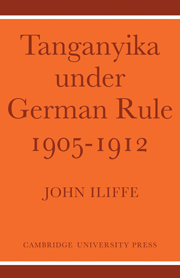Book contents
- Frontmatter
- Contents
- Preface
- Terminology
- Abbreviations
- Glossary
- Map of Tanganyika in 1912
- 1 The argument
- 2 The Maji Maji rebellion
- 3 The political context
- 4 Rechenberg and reconstruction
- 5 The European challenge
- 6 White man's country
- 7 The collapse of the local compromise
- 8 The age of improvement
- 9 The new dilemma
- Bibliography
- Index
7 - The collapse of the local compromise
Published online by Cambridge University Press: 04 August 2010
- Frontmatter
- Contents
- Preface
- Terminology
- Abbreviations
- Glossary
- Map of Tanganyika in 1912
- 1 The argument
- 2 The Maji Maji rebellion
- 3 The political context
- 4 Rechenberg and reconstruction
- 5 The European challenge
- 6 White man's country
- 7 The collapse of the local compromise
- 8 The age of improvement
- 9 The new dilemma
- Bibliography
- Index
Summary
The reshaping of German East Africa during Rechenberg's governorship was not the result of European action alone. It is necessary also to study the developments taking place within African societies, to analyse their changing responses to colonial rule. This is very difficult. German East Africa was a land of numerous small-scale societies. Uganda's modern history can be written quite reasonably around the nuclear kingdom of Buganda; Kenya's rests on five major tribes and Rhodesia's on two; while the historian of Malawi can focus on valid distinctions between north and south. Tanganyika has no such aid to simplification and order. The historian is therefore obliged either to restrict his study to a single society or group of societies, or to fall back on broad generalisations which can be illustrated only by local examples and which are rarely true of all parts of the country at any one time. This problem is especially difficult for the period with which this study is concerned. It was a time of reorganisation, when the degree and direction of change were often a function of the intensity and nature of European pressure. This pressure was itself most unequal during this period. Remote areas—such as Buha—were still engaged in primary resistance at a time when more accessible regions had already experienced twenty years of European rule.
- Type
- Chapter
- Information
- Tanganyika Under German Rule 1905–1912 , pp. 142 - 165Publisher: Cambridge University PressPrint publication year: 1969



